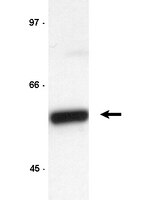05-373-25UG Sigma-AldrichAnti-Cyclin B1
Anti-Cyclin B1 Antibody, clone GNS3 (8A5D12) is a Mouse Monoclonal Antibody for detection of Cyclin B1 also known as G2/mitotic-specific cyclin B1 & has been validated in Immunohistochemistry, Immunoprecipitation and Western Blotting.
More>> Anti-Cyclin B1 Antibody, clone GNS3 (8A5D12) is a Mouse Monoclonal Antibody for detection of Cyclin B1 also known as G2/mitotic-specific cyclin B1 & has been validated in Immunohistochemistry, Immunoprecipitation and Western Blotting. Less<<Recommended Products
Overview
| Replacement Information |
|---|
| References |
|---|
| Product Information | |
|---|---|
| Format | Purified |
| Control |
|
| Presentation | Protein G purified mouse IgGs in storage buffer containing 0.1 M Tris-glycine, pH 7.4, 0.15 M NaCl, 0.05% sodium azide. Frozen at -20°C. |
| Quality Level | MQ100 |
| Physicochemical Information |
|---|
| Dimensions |
|---|
| Materials Information |
|---|
| Toxicological Information |
|---|
| Safety Information according to GHS |
|---|
| Safety Information |
|---|
| Packaging Information | |
|---|---|
| Material Size | 25 μg |
| Transport Information |
|---|
| Supplemental Information |
|---|
| Specifications |
|---|
| Global Trade Item Number | |
|---|---|
| Catalog Number | GTIN |
| 05-373-25UG | 04054839342370 |
Documentation
Anti-Cyclin B1 Certificates of Analysis
| Title | Lot Number |
|---|---|
| Anti-Cyclin B1 - 3758638 | 3758638 |
| Anti-Cyclin B1 - 3979407 | 3979407 |
| Anti-Cyclin B1 - 4157710 | 4157710 |










